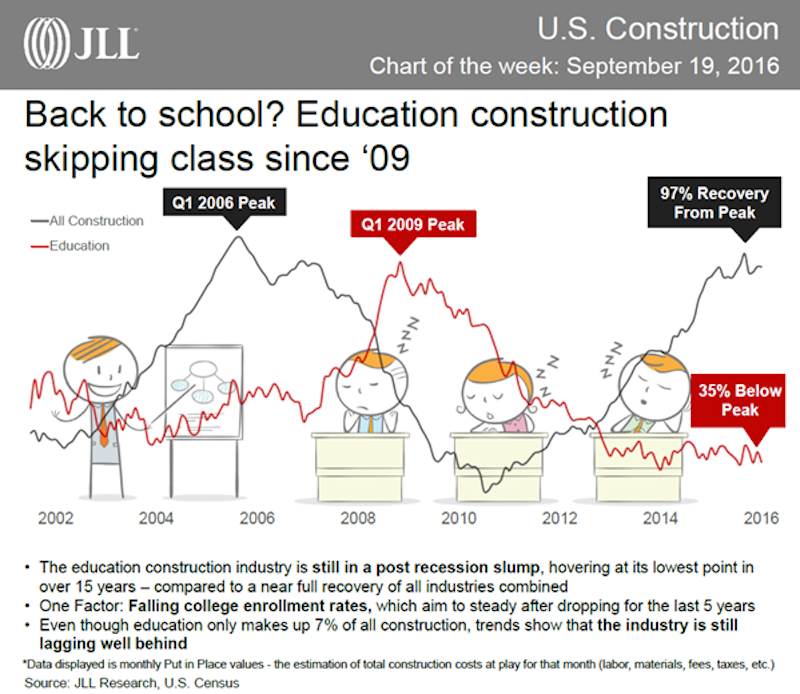Construction investment in the education sector is still in a post-recession slump, even as spending on all construction continues to rise from its low point in early 2011.
The latest “Construction Put in Place” estimates from the Census Bureau show total construction spending in August at $1.142 trillion. That’s a 97% recovery from the most recent spending peak in the first quarter of 2006, and 51.4% higher than the Census estimate for January 2011, $754.7 billion, which was the lowest point for construction during the recession.
The education sector remains one of the biggest in terms of nonresidential construction put in place. But Census’ August 2016 estimate for this sector—$86.1 billion—is still 35% below the peak spending for this sector in the first quarter of 2009.
Indeed, while construction in general has been on the upswing for nearly six years, the education sector has been plummeting from its most recent high of $108.8 billion in May 2009, with a few blips of life in between. Over the past few years, education construction spending has leveled off, though it’s still below the investments in the early and mid 2000s.
Mason Mularoni, JLL’s Project Development and Construction Research Lead, notes that education’s recent peak was mostly stimulated by government funding. “It was almost countercyclical to commercial real estate as the whole.” But in the last several years, government spending has dried up in all but a handful of states (like Texas and California), as school enrollment has fallen off.
“On the demand side, with enrollment flat, state funding has been flat to down,” says Brain Terrell, JLL’s Managing Director and Higher Ed Practice Group Lead.
At the same time, universities find themselves in what Terrell calls a “keeping up with the Joneses” dilemma, where recruiting and retaining students often hinge on the relative quality of a campus’s academic and living facilities and amenities.
To stay in the race, Terrell says more colleges are financing new construction via public-private partnerships, and are leaning toward projects that can produce revenue streams, such as housing, dining, parking and other facilities that might have user fees attached.
Terrell and Mularoni note, too, that education spending is down because many colleges are focused on expanding their graduate school attendance. “So much of undergraduate [learning] can be done online, so why spend more on classrooms?” Terrell says.
A similar dynamic is occurring at the elementary and high school levels, where a growing number of school districts are consolidating schools, and are aligning themselves with teaching pedagogies that incorporate online research into the curriculum. The conventional classroom is giving way to more open collaborative spaces that include outdoor areas.
The question now is whether education construction spending will continue to decline, or if—as data for the past few years show—it will settle at its current level?
Mularoni concedes that the spending peak was probably inflated and unsustainable. “But if you look at the numbers, spending now isn’t that far off from what it was in 2004. We see spending in the future falling somewhere in between these years, because the institutions still say their campuses are in great need of renovation and new construction.”
Related Stories
Resiliency | Jun 24, 2021
Oceanographer John Englander talks resiliency and buildings [new on HorizonTV]
New on HorizonTV, oceanographer John Englander discusses his latest book, which warns that, regardless of resilience efforts, sea levels will rise by meters in the coming decades. Adaptation, he says, is the key to future building design and construction.
K-12 Schools | Jun 20, 2021
Los Angeles County issues design guidelines for extending PreK-12 learning to the outdoors
The report covers everything from funding and site prep recommendations to whether large rocks can be used as seating.
Wood | Jun 10, 2021
Three AEC firms launch a mass timber product for quicker school construction
TimberQuest brand seeks to avoid overinvestment in production that has plagued other CLT providers.
Multifamily Housing | Jun 3, 2021
Student Housing Trends 2021-2022
In this exclusive video interview for HorizonTV, Fred Pierce, CEO of Pierce Education Properties, developer and manager of off-campus student residences, chats with Rob Cassidy, Editor, MULTIFAMILY Design + Construction about student housing during the pandemic and what to expect for on-campus and off-campus housing in Fall 2021 and into 2022.
Digital Twin | May 24, 2021
Digital twin’s value propositions for the built environment, explained
Ernst & Young’s white paper makes its cases for the technology’s myriad benefits.
Market Data | Feb 24, 2021
2021 won’t be a growth year for construction spending, says latest JLL forecast
Predicts second-half improvement toward normalization next year.
Modular Building | Jan 26, 2021
Offsite manufacturing startup iBUILT positions itself to reduce commercial developers’ risks
iBUILT plans to double its production capacity this year, and usher in more technology and automation to the delivery process.
Giants 400 | Dec 16, 2020
Download a PDF of all 2020 Giants 400 Rankings
This 70-page PDF features AEC firm rankings across 51 building sectors, disciplines, and specialty services.
AEC Tech | Nov 12, 2020
The Weekly show: Nvidia's Omniverse, AI for construction scheduling, COVID-19 signage
BD+C editors speak with experts from ALICE Technologies, Build Group, Hastings Architecture, Nvidia, and Woods Bagot on the November 12 episode of "The Weekly." The episode is available for viewing on demand.
Smart Buildings | Oct 26, 2020
World’s first smart building assessment and rating program released
The SPIRE Smart Building Program will help building owners and operators make better investment decisions, improve tenant satisfaction, and increase asset value.



![Oceanographer John Englander talks resiliency and buildings [new on HorizonTV] Oceanographer John Englander talks resiliency and buildings [new on HorizonTV]](/sites/default/files/styles/list_big/public/Oceanographer%20John%20Englander%20Talks%20Resiliency%20and%20Buildings%20YT%20new_0.jpg?itok=enJ1TWJ8)













